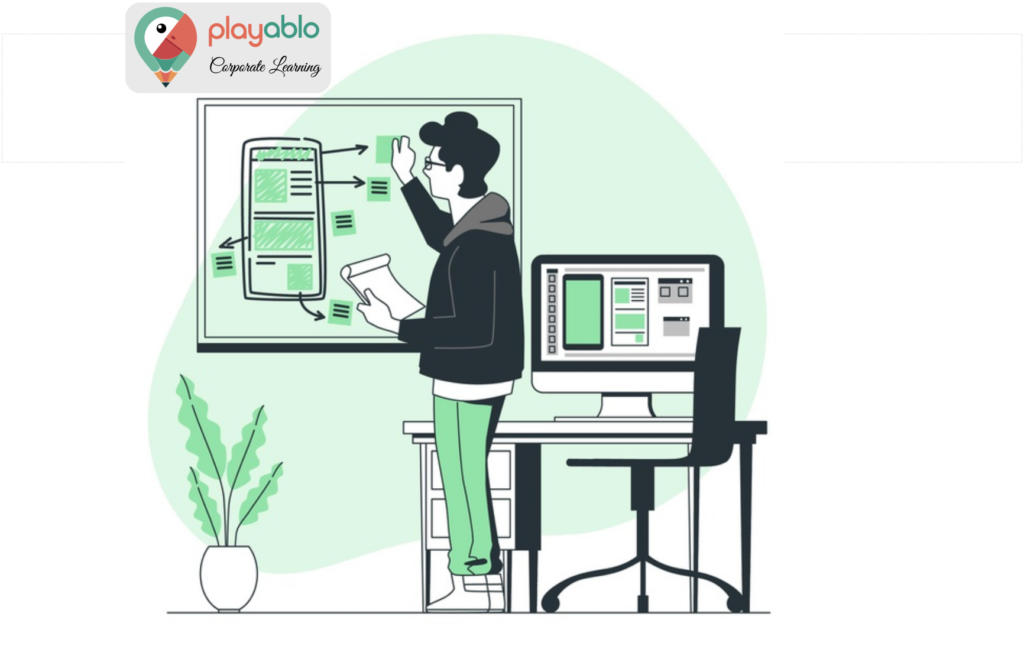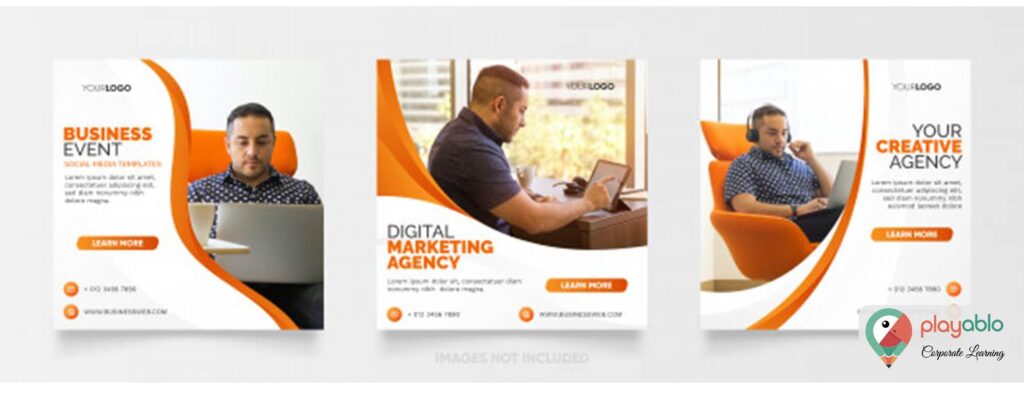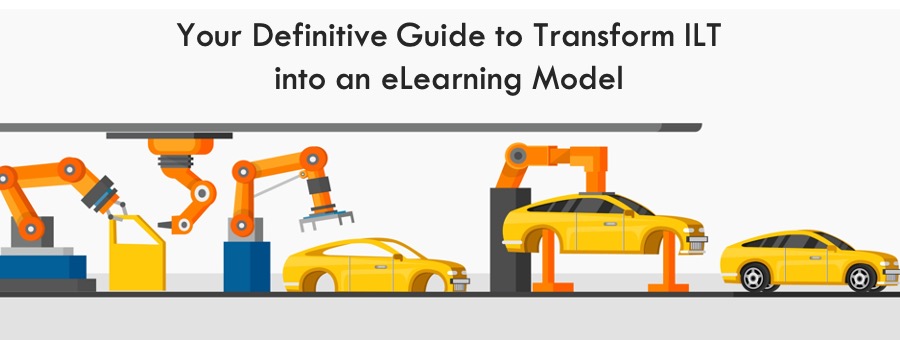Classroom-based Instructor-Led Training (ILT) might seem traditional, but there is a strange nostalgia attached to it. Even though companies are increasingly opting for online learning, good old ILT has that human touch missing in the virtual environment. However, in the current scenario, Instructor-Led Training does not hold many upsides when you compare online vs. offline education. Apart from it being costly, offline sessions have a limited reach.
They are also not suited for a globally dispersed, diverse workforce. These are the reasons why several L&D teams have approached us with one question — how to convert ILT to eLearning? An enterprise LMS, such as PlayAblo, will serve as a backbone in this transformational journey, but you also need a well thought out execution plan to make the journey. Let’s start!
Well, for starters, classroom training contains elements like icebreaker sessions, demos, hands-on activities, and role-plays. How do you replicate them in an online course? By incorporating features such as attention grabbers, videos, simulations, and scenarios. Yes, there are several ways via which you can create an immersive experience with online sessions as well. How? Our detailed guide is here to help you out! We break this guide down across three key areas: People – Process – Tools & Technology.
Read More: Your Go-to Guide to Convert PPT to Mobile Learning
Table of Contents
PEOPLE
Get Organised

‘Organisation’ is vital for a successful ILT to eLearning conversion. Identify all the staff members who will serve as the major participants during the transition. Get onboard your instructional designers (IDs), Subject Matter Experts (SMEs), and support staff. Assign clear roles and responsibilities and explain the areas where they will have joint responsibilities.
Involve the SME
It’s highly critical to involve the SME in your ILT to eLearning conversion project since s/he has a pivotal role to play. In classroom training, your instructor is the primary contact point between the trainees and the content. Whenever there is confusion, s/he clarifies the issue with the help of relevant examples or case studies. If you cannot incorporate this knowledge in your eLearning course, you will lose some vital inputs.
Hence, seek the guidance of the SME to address gap areas in your content. Ask him/her to give a detailed explanation, when required so that you can include the vital information in the eLearning course. For instance, the instructor could have explained a concept with a video. So, make sure to include that clip in one of the online modules. It is always a great idea to involve SMEs in eLearning course reviews, especially when the training is technical.
Choose a Segment of Your End Audience for Pilot Testing
Usually, organisations roll out an eLearning course soon after completing the quality assurance (QA) checks. However, it would be best if you always considered your end audience. They can offer valuable feedback to improve course quality. You can choose a group of users from the target audience for whom the course is intended. They serve as the pilot group — that should be a diverse mix of participants in terms of age, race, gender, ethnicity, and experience. Once they finish a specific segment of the training program, collect their inputs through a feedback form and incorporate the feedback in the next version of your eLearning course.
PROCESS
Transfer Your Legacy Content to eLearning

A successful transition from ILT to eLearning demands a vast deal of prep work. NEVER kick off the process by doing a one-for-one conversion. Taking one slide at a time and making an exact online replica of it is futile. All you will end up with is an eBook without delivering an enhanced learning experience to your learners. What you can do is start by analysing your already existing inventory.
Start the Process by Noting Down Your Existing Inventory
Your traditional ILT might have consisted of materials such as projected slides, hand-outs, workbooks, course notes, audio and video files, and worksheets. You may also own auxiliary materials like answer sheets, student guides, and feedback forms. First up, assemble all of these resources in a single place.
Read More: Checklist for Implementing Your Enterprise LMS!
Understand the Original Purpose of the Course
The next step is to understand ‘why’ you want an eLearning course in the first place. Then, begin to sort the old materials and transform them into their digital counterparts. For example, suppose you mean your flow charts to help learners understand and then apply process flows to the proper procedure. In that case, you can introduce an interactive element to drag the flow components and connect them to the respective procedures online.
Review and Revise
Reviewing is also an essential aspect of the transition. Check if there is obsolete or wrong information in your old course materials. Flag those areas and replace them with the correct or updated versions. Again, several instructor-led training usually reiterates the same fundamental concepts. When making the transition, rather than going for repetitions, link back to previous content instead of converting it multiple times.
Observe
Another valuable tip to convert ILT to eLearning is sitting through a traditional training session in progress, which uses the current materials. Your team can then gain insights on how to turn some of the paper-based materials into digital content. You can additionally understand essential design aspects in the online course. Also, you can identify potential gap areas in the existing content and address them in the conversion phase.
TOOLS AND TECHNOLOGY
Concentrate on The Formats Of Content Presentation

You can decide on the eLearning format after knowing the content and its exact context. For example, if you have to guide learners through performing a task that involves complex information, you can embed a short informative video. It would be best to incorporate quizzes and gamification elements to make the session simpler and more engaging. Another tool that you can use to make online sessions enjoyable is an infographic — that shows the steps to complete a process. One can use the infographic as a job aid. PlayAblo’s solution packs in elements like videos, infographics, flowcharts, podcasts, interactive PDFs, and quizzes — which are handy digital formats when converting ILT to eLearning.
Reinvent and Restructure
During the ILT to eLearning conversion phase, you should take a step back and rethink the purpose of all of your existing content. You will find several areas where you can reconfigure existing content to make it more user-friendly and better adaptable to eLearning. For example, if you have long texts, try converting them into graphics, images, or pictures. Are there multiple static images, followed by long paragraphs? Then, maybe, you can use the mouse over functionality or Hotspot interactions. Multi-media courses give better outcomes by discarding extensive text-based content.
Reduce
In online training, you need to simplify texts to the extent that they do not overwhelm the reader. A cluttered, packed screen will effortlessly bore learners. One of the best methods to deliver effective eLearning programs is to break up massive lessons into bite-sized parts. Usually, each sub-module should be no longer than 12 to 15 minutes. Again, rather than resorting to repeated summarisation, add a sidebar to the course. With the help of a solution like PlayAblo, in-house experts will analyse your entire existing course materials and convert them into easily digestible, engaging microlearning.
Use Templates

You can use templates to give a quick start on the ILT to the eLearning conversion process. Several eLearning authoring tools deal with many templates such as Lectora Inspire, Articulate Storyline, and Adobe Captivate. These tools lend a consistent look to slide layouts and stick to company branding guidelines. You can also include interactivities and cut down on the time and effort involved in converting classroom training activities to eLearning.
Opt for Collaborative Learning
One of the most significant upsides of ILT is that it contains an instructor – who makes the classroom interesting by facilitating discussions and encouraging questions. You can include this element in eLearning by opting for collaborative learning. For instance, you can provide discussion forums on your LMS. Also, a discussion or message board in the LMS enables learners to interact with each other. Learners can post doubts on a topic, and peers can answer questions.
Ad: PlayAblo’s Enterprise-Grade Micro-Learning platform is for the modern corporate learner. Micro-Learning, along with assessments and gamification features, ensures learning outcome measurement along with sustained engagement.
Find out more and request a custom demo!
Select the Apt Design Strategy
In eLearning, you need to choose an effective strategy to hook learners, including instructional and visual design. For instance, you may think of engaging learners with a storytelling strategy or a scenario-based eLearning course. When you have the interactive elements in place, you can kick off creating the instructional and visual design strategies. You can finally begin to draft the storyboard — a blueprint of the eLearning course, inclusive of all the text and graphical elements of the course. However, ensure to get the approval of the prototype from stakeholders.
Ad: PlayAblo’s Enterprise-Grade Micro-Learning platform is for the modern corporate learner. Micro-Learning, along with assessments and gamification features, ensures learning outcome measurement along with sustained engagement.
Find out more and request a custom demo!
Some of the design strategy elements include engaging formats, professional voiceovers for audio narration, language style, and tone, among others. Other components are typography, images, colour palette, company logo, and organisational branding guidelines.
Conclusion
It would help if you always prepared before embarking on your ILT to eLearning conversion project. Consider the pointers mentioned above when you are transitioning from ILT to eLearning. And with the help of a solution like PlayAblo, you will be able to create a full-fledged online training program that exceeds the bar set by a traditional classroom training program.







1 Comment
Comments are closed, but trackbacks and pingbacks are open.